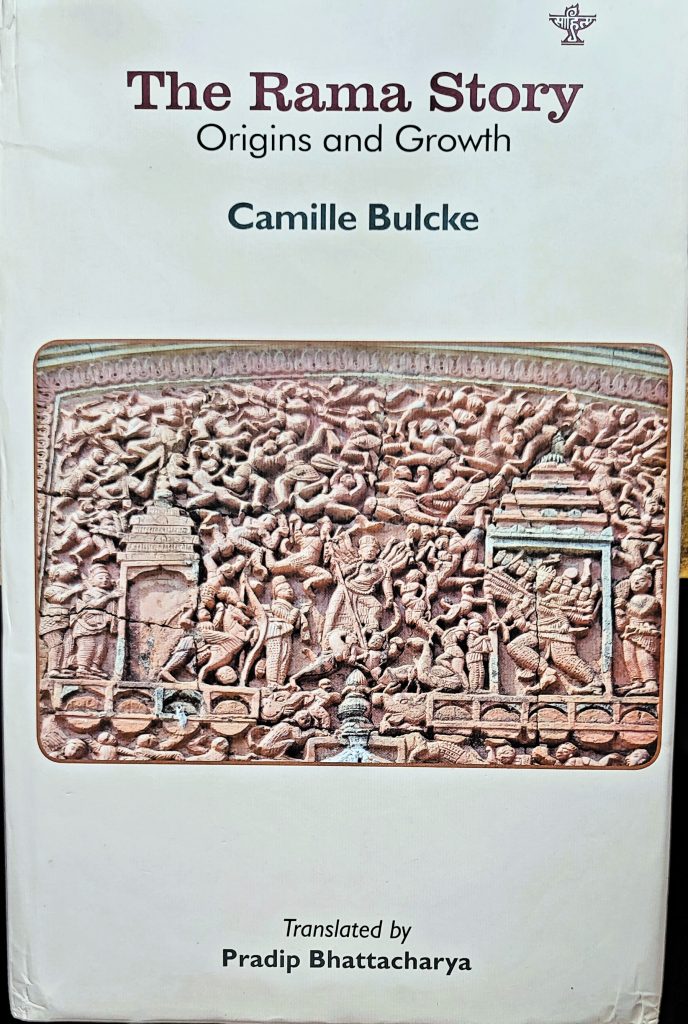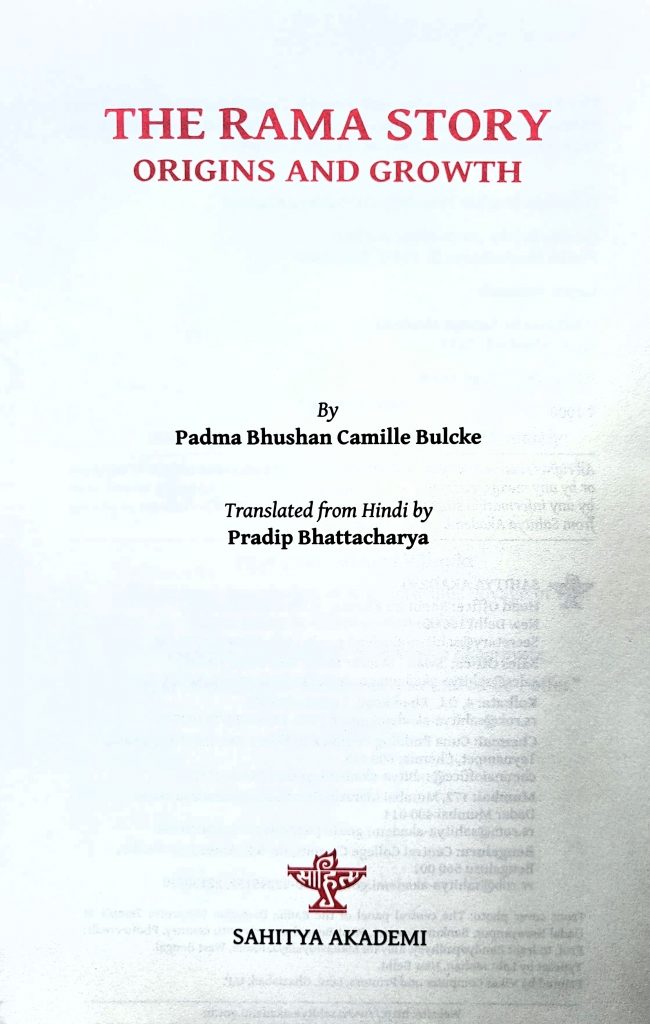Bulcke
Book Review of Fr. Camille Bulcke’s THE RAMA STORY: ORIGINS AND GROWTH (2022)
Trans. (from Hindi) by Pradip Bhattacharya. Delhi: Sahitya Akademi. Hardbound.
ISBN: 9789355481108
Oshin Vipra Sagar, Avinash Kumar
Kalākalpa, Vol. VII, No. 2(2023)
With some variation, the story of Rama is told not just across different parts of the Indian subcontinent but also in Southeast Asia with just as much fervour. Not to forget, Ram and his supposed birthplace have become a part of the politico-religious fabric of India over the last few decades. Therefore, a historical inquiry into the story of Rama is a pertinent endeavour now more than ever. However, no systematic historiographical work on Rama’s tales was available for general readers and academics alike until a Belgian Jesuit priest Father Camille Bulcke accomplished the task of comprehensively tracing the origin and development of the narratives around Rama in his magnum opus “Ramkatha: Utpatti Aur Vikas” published in 1950. The work, however, remained accessible only to readers and researchers proficient in Hindi. The translation by Pradip Bhattacharya bridges that gap for the anglophone public through his work ‘The Rama Story: Origins and Growth’, published by Sahitya Akademi in August 2022.
Pradip Bhattacharya’s ambitious translation has surveyed the major available editions of Father Bulcke’s original work. He has taken into cognisance the printer’s gremlins (in the 16th ed.) and tried his best to critically examine the errors and omissions before producing his translation based primarily on the third edition of Bulcke’s work published in 1971 by Hindi Parishad Prakashan, Allahabad University. Bhattacharya also acknowledges the original writer’s lack of awareness of his predecessors’ work relating to Ramayana at large such as those by Akshoy Kumar Maitreya, who, for example, has dealt with the subjects Bulcke deals with (say, Ramayana’s relationship with Greek and Buddhist stories) or Rajasekhara P.Basu’s ‘Surpanakha Reminiscences’ and ‘the Rule of Rama’ or Kumudini’s ‘Sita’s Letters.’
Father Bulcke’s omissions of the verse number and translation of Sanskrit verses too, have been supplemented in the translated work by Bhattacharya, making it fairly corroborated and accessible. Nonetheless, the translator has ensured that they stay true to the original and preserve its appearance while addressing the need to rectify some inconsistencies in referencing style.
‘The Rama Story: Origins and Growth’ wholeheartedly follows the structure of Bulcke’s “Ramkatha: Utpatti Aur Vikas”, wherein the work is divided into four main parts, each corresponding to the four major stages of the evolution and expansion of the Rama story. The first part (consisting of chapters 1 to 5) concerns itself with the extant ancient literature such as the Vedic, Buddhist and Jain corpus – scrutinising the references to the Rama story they present. The first chapter reviews the Vedic literature for the presence of characters like Iksvaku, Dasaratha, Janaka, and Sita as the presiding deity of agriculture while also presenting an apparent absence of Rama in the corpus. The second chapter examines the three recensions of Valmiki’s Ramayana and attempts to gauge the time of its composition historically. It also disambiguates the identity of the author of Ramayana, the poet Valmiki and sheds light on the various Valmikis. The third chapter brings some fascinating insights to the table regarding the timeline of Valmiki’s Ramayana with reference to the other epic of the subcontinent, i.e., the Mahabharata (hence, Mb). Verses from the primary text of Mb have been used to illustrate how the composers of Mb were aware of Valmiki and his work – while maintaining a distinction between the stories of Bharata and the Mahabharata. At the same time, the readers are also provided with quantitative cues to the popularity of the Rama story: for example, how approximately fifty references to Rama or characters related to his story are found in Mb.
In part two of the work, chapter 6 critically examines the origins of the story of Rama: addressing the problematic nature of “Dasaratha Jataka” and the question of the authenticity of the Pali “Jatakakathavannana.” In the consecutive chapter, the discussion follows through on the matter by taking into consideration the views of scholars such as Dr. Weber, Jacobi and Dineshchandra Sen. Chapter 8 and 9 remarks on the main interpolations in Valmiki’s Ramayana and how the concept of the ‘avatar’ contributed to its wide dispersal.
The third part of the book provides an overview of the wide and deep penetration of the Rama story across medieval literature from the subcontinent across Sanskrit, modern Indian languages, and other Asian languages. In this part, chapter 10 elucidates on the development of Rama-bhakti and the Rama stories in Puranic literature (Harivamsa, the Mahapuranas and the minor Purana) as well as the sectarian Ramayanas and other religious literature from the period. The subsequent chapter 11 traces and maps the Rama story across an elaborate list of Sanskrit belle letters beginning with Raghuvamsa, Setubandha and covering about 17 major works, including epic poetry and plays, while further covering some minor works. Chapter 12 of the work is divided into two parts: the first discusses the Ramayana across Southern languages of Tamil, Telugu, Malayalam, and Kannada, including the tribal tales related to Rama from the region; the second discusses the Rama story in the literary works produced in northern Indian languages as well as Sinhalese. The two parts of this chapter correspond to Bulcke’s rough categorisation of linguistic groups as Dravidian and Aaryan, which could be better titled in the translation to be technically more accurate and not appear anachronistic. The last part, chapter 14, discusses the Rama story abroad in the Tibeto-Khotanese, Indonesian, Indo-Chinese (Vietnamese), Siamese and Burmese traditions while briefly touching upon the Western narratives.
The fourth and final part of the book expounds on the growth of the Rama story spread over seven Kandas (Bālakāṇḍa, Ayodhyakāṇḍa, Araṇyakāṇḍa, Kiṣkindakāṇḍa, Sundarākāṇḍa, Yuddhakāṇḍa, Uttarakāṇḍa) in chapters 14-20. It ends with concluding remarks in the 21st and the last chapter of the volume. This part of the book, from pg. 341 to pg. 892 amounts for the bulk of the volume that closely engages in dissecting the minutest details of themes and episodes of each Kanda and the variations of each, if any, across the three recensions of Valmiki’s Ramayana.
As for relevant original additions, Bhattacharya (supplementing Bulcke’s original list) brings to the readers an organised exhaustive bibliography comprising ancient texts as well as modern works across Indian and foreign languages in Appendix I. Appendix II sheds light on the story wherein Rama had to shoot an arrow at Hanuman on Viswamitra’s command, an intriguing episode relating to Rama that Bulcke skipped in his almost encyclopaedic work. In Appendix III, Bhattacharya elucidates on the large yet relatively less-known Ramayana frescoes in the Silver Pagoda at Phnom Penh, Cambodia, commissioned between 1903-04. The frescoes depict the Khmer story of Rama being abducted by Ravana’s nephew Waireab and his rescue by Hanuman. Finally, in Appendix IV, he reviews Paula Richman’s ‘Questioning Ramayana’ and Amreeta Syam’s ‘Kaikeyi.’
Overall, the book is worth all the attention at present and for times to come. Priced at INR 1500/- this 990-page book is a comprehensive wellspring of information on the narratives surrounding the character of Rama, which historically traces their antiquity while critically examining its growth through the ages.
The Rama Story
(Rama-Katha) by Padma Bhushan Camille Bulcke, S.J.



Translated from Hindi by Pradip Bhattacharya
published by Sahitya Akademi
secretary@sahitya-akademi.gov.in